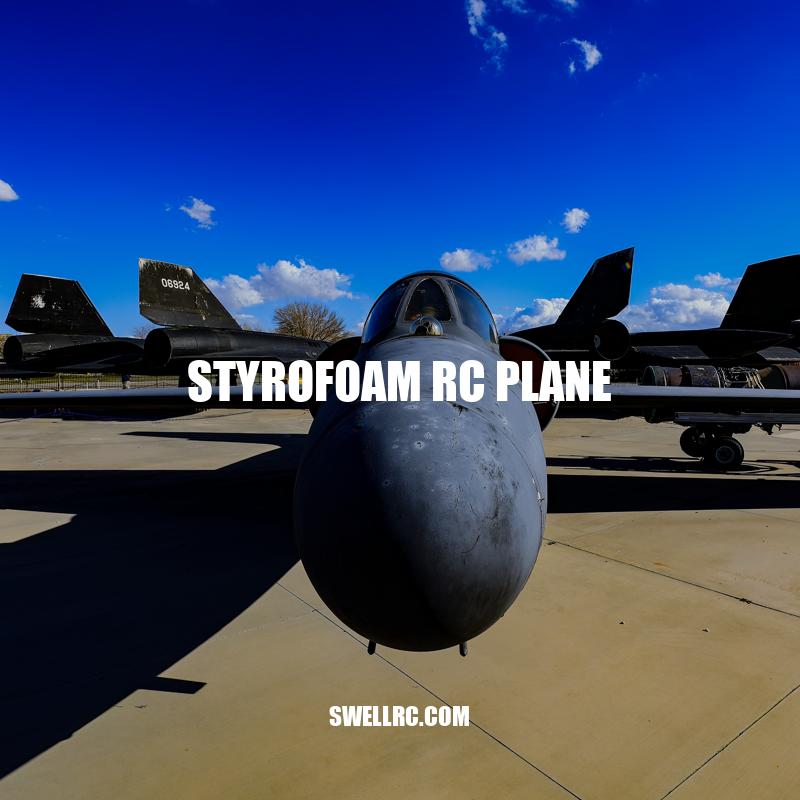Styrofoam RC Plane: A Beginner’s Guide.
Styrofoam RC planes are becoming a popular choice among hobbyists of all levels, especially those looking for an affordable and easy-to-build option. These planes are made of lightweight, durable foam, making them an excellent choice for beginners who may crash their planes several times in the learning process. Building a styrofoam RC plane is a satisfying and rewarding hobby that can be enjoyed by all ages. While building and flying these planes can be a lot of fun, there are many steps to consider before getting started. In this article, we’ll take a closer look at the process of building a styrofoam RC plane, from the materials needed to the testing phase. Whether you’re an experienced RC pilot or a beginner, this guide will provide you with all the information you’ll need to build a quality styrofoam RC plane and take to the skies.
Materials Needed To Build A Styrofoam RC Plane
Before building your styrofoam RC plane, it’s important to make sure you have all the necessary materials on hand. Here are the key items you’ll need to get started:
- Styrofoam:
- High-density foam is preferred as it is more durable than standard foam for RC planes.
- Radio Control System:
- Most RC planes require a 2-channel system, which includes a receiver and transmitter.
- Speed Controller (ESC):
- This controls the power to the motor and should match the motor’s specs.
- Battery:
- Choose a LiPo battery that matches the ESC’s specs.
- Aim for a slightly higher capacity than the ESC’s requirements to provide longer flight times.
- Motor:
- Choose a motor that is compatible with the other parts and will fit in the plane’s design.
- Propeller:
- Find a propeller that is compatible with the motor and provides optimal thrust.
- Other Tools:
- Utility knife or foam cutter
- Measuring tape or ruler
- Gorilla glue or other foam-friendly glue
- Sandpaper or sanding block
- Paint and brushes (optional for finishing touches)
It’s important to note that while styrofoam RC planes are relatively affordable and easy to build, investing in quality materials will greatly improve the durability and longevity of your plane. Some popular websites to purchase these materials from include HobbyKing, RCGroups and Tower Hobbies.
What Styrofoam is used for RC planes?
Styrofoam is a popular material used in RC (radio-controlled) planes due to its lightweight and durable properties. It is commonly used for the wing and fuselage of the aircraft.
There are many types of Styrofoam available on the market, with varying densities and strengths suitable for different types of planes. Some popular types of Styrofoam for RC planes are:
- Expanded Polystyrene (EPS): This type is lightweight and easy to work with, making it an excellent choice for beginners.
- Extruded Polystyrene (XPS): This type is denser and more rigid than EPS, making it ideal for larger planes and high-speed flights.
- Depron: A type of expanded polystyrene foam specifically designed for modeling and RC planes. It is lightweight and easy to shape, but more expensive than other options.
It’s important to note that not all Styrofoam is suitable for RC planes, and it’s essential to choose the right type for your project. Some recommended websites for purchasing Styrofoam for RC planes include HobbyKing and Tower Hobbies.
Installing The Electronics Into Your Styrofoam RC Plane
Once you have your materials in hand, it’s time to install the electronics into your styrofoam RC plane. This process is critical to the plane’s overall performance, and requires careful attention to detail. Here are the steps to follow:
- Install the ESC (electronic speed control) onto the motor.
- Attach the motor to the plane’s frame using a foam-friendly glue
- Install the push rods and servo motors for control surfaces like the rudder and elevator using hot glue or epoxy.
- Mount the receiver using foam-friendly adhesive onto a safe and secure location inside the plane, away from any moving parts.
- Plug the servo motors and ESC into the receiver according to the manual’s specifications.
- Attach the battery to the ESC and secure firmly to the frame with Velcro or a foam-safe strap.
- Attach the propeller to the motor shaft and ensure it spins freely.
It’s important to test your electronics before flying the plane. You can do this by turning everything on and making sure there are no issues with the motor, control surfaces, or receiver.
Here’s a comparison table of some popular ESCs available for styrofoam RC planes:
| ESC | Price | Continuous Current (A) | BEC Voltage (V) |
|---|---|---|---|
| Hobbywing Skywalker | $10.99 | 20A | 5V/2A |
| SimonK 30A | $12.99 | 30A | 5V/3A |
| TURNIGY Plush | $14.99 | 30A | 5V/2A |
It’s important to choose an ESC that meets the specifications of your motor and fits inside your plane’s design. Some popular websites to purchase ESCs and other electronics for your styrofoam RC plane include HobbyPartz and Banggood.
What electronics do I need to build an RC plane?
To build an RC plane, you will need several electronics. Here is a list of essential electronics for building an RC plane:
- A transmitter and receiver
- A brushless motor
- Electronic Speed Controller (ESC)
- LiPo battery and charger
- Servos
- Propeller
- Flight Controller (optional)
There are various online stores that offer a wide range of RC plane electronics such as HobbyKing, Amazon, and Banggood. Make sure to choose high-quality components to ensure a smooth and successful build.
After you’ve installed your electronics, the next step is to paint and add finishing touches to your styrofoam RC plane. These finishing touches not only make the plane look better, but can also improve its aerodynamics. Here are some tips on how to paint and add finishing touches:
– Use a foam-safe paint like Krylon Fusion for Plastic or Rust-Oleum Universal to avoid damaging the foam material.
– Choose an eye-catching design and color scheme to make your plane stand out.
– Use tape or vinyl decals to create logos or designs on the plane.
– Apply a coat of clear spray paint to add a layer of protection to the foam and your paint job.
– Consider adding weight to the nose of the plane to balance it properly and improve its flight performance.
– Install landing gear or wheels to make it easier to take off and land.
– Add lights to the plane to fly it at night.
Here’s a comparison table of some popular foam-safe paints available for styrofoam RC planes:
| Brand | Price | Color | Coverage |
|---|---|---|---|
| Krylon Fusion for Plastic | $8.99 | Gloss White | 12 sq. ft. |
| Rust-Oleum Universal | $10.99 | Flat Soft Iron | 12 sq. ft. |
| Rust-Oleum 2x Ultra Cover | $7.99 | Satin Oasis Blue | 12 sq. ft. |
It’s important to get the right type of paint for the foam material to avoid damage. You can purchase foam-safe paint from your local hobby store or online websites like Amazon or RC Plane Master. With a little creativity, you can make your styrofoam RC plane look unique and fly like a dream.
How do you paint a foam RC plane?
To paint a foam RC plane, you’ll need the following:
- Acrylic craft paint
- Fine grit sandpaper
- Paint brushes
- Masking tape
Here’s a step-by-step process for painting your foam RC plane:
- Clean the foam surface with warm water and mild soap to remove any dirt or oil.
- After it dries completely, use fine grit sandpaper to lightly sand the surface.
- Mask off any areas you don’t want to be painted with masking tape.
- Using acrylic craft paint, apply a layer of primer, let it dry completely.
- Once the primer has dried, apply the color coats of paint of your choice.
- Finally, seal the paint with a clear coat of varnish or polyurethane.
Be cautious while painting foam planes as using the wrong type of paint or solvent can melt the foam. Always test the paint on a small area before applying to the entire plane.
If you require more detailed instructions or want to see visual tutorials, you can check out various video tutorials on sites like YouTube or forums like RcGroups.com. There are also numerous tutorials and guides available on RC hobbyist websites such as MotionRC.com and FliteTest.com.
Styrofoam RC plane testing and flying can be exciting and fun, but it’s important to take necessary precautions to avoid crashes or equipment damage. To ensure a successful flight, it’s best to perform an indoor or controlled environment test before flying a styrofoam RC plane outdoors. It’s also important to perform a range check to ensure that the plane is receiving signals properly.
For beginners, it’s recommended to start with short flights until they get comfortable with the controls. It’s best to avoid flying in bad weather or strong winds, and to maintain a safe distance from people and objects that could pose a potential collision risk. Using the recommended battery for the plane is crucial to avoid damaging the electronics. It’s also important to make sure the plane is properly balanced and trimmed before flying.
There are a number of resources and tools available online to help test and fly styrofoam RC planes. The RC Groups forum provides hobbyists with advice on building, flying, and maintaining RC planes. Flite Test, a popular RC plane YouTube channel, offers instructional videos on building, testing, and flying RC planes. They also sell kits and parts for styrofoam RC planes on their website. For purchasing RC planes, Horizon Hobby is an online retailer that offers a variety of models and provides advice and information on testing and flying RC planes on their website.
By taking the time to properly test and fly a styrofoam RC plane, enthusiasts can enjoy hours of flying fun and avoid equipment damage or unnecessary crashes.
How do you protect a foam RC plane?
To protect a foam RC (remote control) plane, you can follow these tips:
- Apply clear packing tape or vinyl tape to the leading edges and other vulnerable parts of the plane.
- Use a foam-safe “paint” such as Minwax Polycrylic to give the foam a hard, protective coating.
- Use foam-safe CA (cyanoacrylate) glue to fix any damage immediately to prevent further damage.
- Store the plane in a cool, dry place away from direct sunlight and extreme temperatures.
Additionally, there are products available specifically designed to protect foam RC planes, such as Rust-Oleum NeverWet and 3M Super 77 Spray Adhesive. Websites like RCGroups.com and Flite Test offer helpful tips and forums for RC enthusiasts.
Maintenance and Care for Your Styrofoam RC Plane
Taking care of your styrofoam RC plane is important to ensure its longevity and performance. Here are some tips on maintenance and care for your plane:
- Keep the plane clean to prevent dirt and debris from building up and to avoid interference with the electronics.
- Store the plane in a dry, cool place to avoid moisture and damage to the electronics.
- Inspect the plane for damage after each flight and make any necessary repairs before the next flight.
- Replace any damaged or worn out parts to maintain optimal performance.
- Check the battery regularly to ensure it is charged and not damaged.
- Keep spare parts on hand in case of any unexpected damage or malfunctions.
There are also some online resources available for maintenance and care of your styrofoam RC plane:
- The RC Plane Center is a website that offers tutorials and videos on how to repair, maintain, and upgrade your RC plane.
- Flite Test also offers instructional videos on how to fix and maintain your styrofoam RC plane on their YouTube channel and website.
- Hobbyking is an online retailer that sells a variety of RC planes and parts. They also offer advice and information on maintenance and care for your plane on their website.
By taking proper care of your plane, you can maximize its lifespan and performance, and continue to enjoy flying it for years to come.
Is Styrofoam good for RC planes?
Styrofoam is a popular material used in making RC planes due to its light weight and durability. However, it is not the only material option available. Other materials like balsa wood, carbon fiber, and foam boards can also be used. It depends on the design, intended use, and personal preference of the RC plane builder. To find more information and resources on building RC planes, websites like Flite Test and RCGroups offer helpful forums and tutorials.
Conclusion
Building and flying a styrofoam RC plane can be a fun and rewarding hobby for anyone that enjoys aviation and technology. Whether you’re a beginner or experienced hobbyist, styrofoam RC planes offer an affordable and accessible way to learn and master the art of flying. With the right tools and guidance, you can build a plane that meets your needs and personal preferences, and experience the thrill of flying high above the ground.
The key to success with styrofoam RC planes is to take the time to learn and practice the fundamentals, and to maintain and care for your plane properly. By following the tips and advice outlined in this article, you can get the most out of your plane and become a skilled and confident pilot.
Remember to always follow safety guidelines and regulations when flying your styrofoam RC plane, and to never operate it near people or property. With patience, practice, and a passion for aviation, you can build and fly your own styrofoam RC plane and experience the joy and satisfaction of mastering a new skill.



